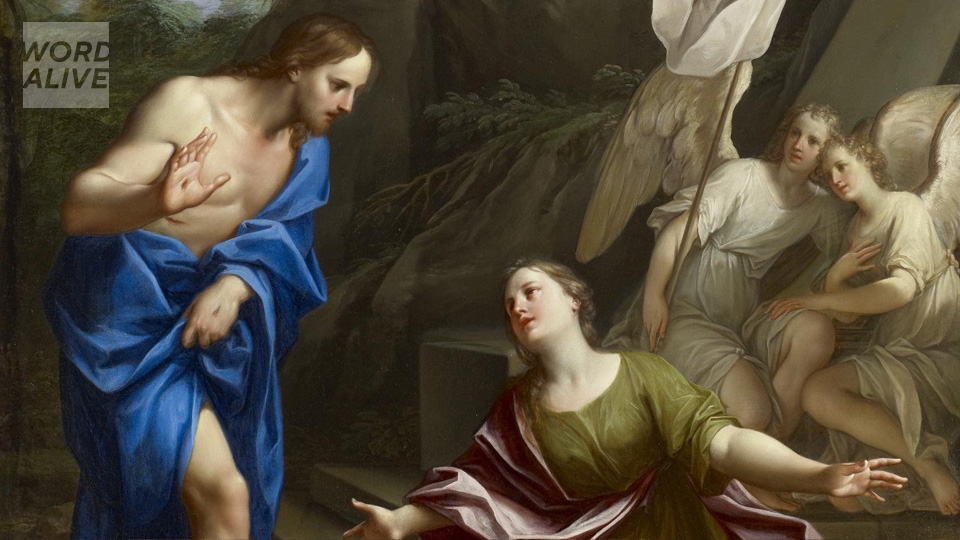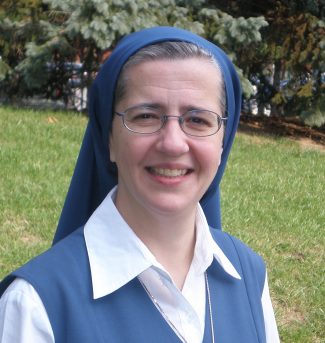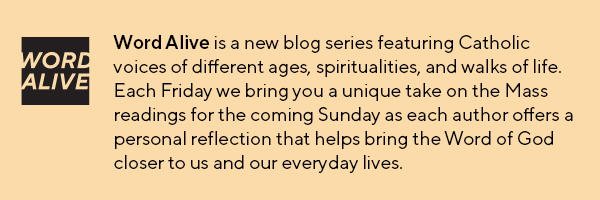



Celebrating Easter in a world turned upside down | Word Alive
Sr. Marie Paul Curley, FSP
Friday, April 10, 2020

“Jesus said to her, ‘Mary!’ She turned and said to him in Hebrew, ‘Rabbouni,’ which means Teacher” (John 20:16). Detail from Noli Me Tangere by Marcantonio Franceschini (Source: Wikimedia Commons)
Celebrating Easter in a world turned upside down
A reflection for Easter Sunday, Year A
by Sr. Marie Paul Curley, FSP
“Mary of Magdala came to the tomb early in the morning, while it was still dark, and saw the stone removed from the tomb.”
John 20:1 (Easter Sunday’s Gospel Reading)
Our experience of Lent this year has been intensified by the distress and restrictions caused by the worldwide pandemic, resulting in a situation many of us would not have imagined six months ago. At the same time, since mid-Lent we have been distanced from Mass and the immersive liturgies for Holy Week. How do we celebrate Easter when our world has turned upside down and we know that the global dark days are not over?
Sharing in the sufferings of the world certainly makes this Easter unique for me, but this is not the first Easter where joyful celebrations have felt out of place or even impossible. Several years ago, my Easter was a time of grief and loss: a close friend had just died of a devastating illness and two family members became seriously ill. Something inspired me to take Saint Mary Magdalene as my guide that Easter, and she has accompanied me through my Lents and Easters ever since. Initially, I chose her because of her immense grief at Jesus’ Crucifixion, but the more I prayed with her, the more I was moved by her relationship with Christ.
Saint Mary Magdalene is the perfect guide through Holy Week and Easter because, even before she met Jesus, she knew darkness and grief on a level that most of us can only imagine: Jesus healed her from seven demons. The Gospels don’t provide any details so we don’t know much about it, but it must have been a terrible experience of darkness.
When Jesus healed her, her desperate soul must have seen the first glimmer of hope—a hope that blossomed as she became Jesus’ follower. We don’t know how long Mary accompanied Jesus during his public life—a month? a year? Maybe long enough for that new, fragile hope to begin to take root in her heart. Nonetheless, her overwhelming sorrow at Jesus’ Crucifixion hints that her Lord’s suffering and death crushed her tender, newfound hope. She comes to visit Jesus’ tomb not because she has hope but because she carries immense grief.
Mary’s anguish at witnessing her beloved Master’s torturous execution left such a profound mark on her that she is the first to come to visit Jesus’ tomb—“while it was still dark.” Interiorly, her soul, too, must have been in the dark. Matthew’s Gospel tells us plainly that Mary Magdalene came to see the tomb. She came to grieve, to mourn, perhaps to try to begin to come to terms with such a great loss.
Mary is focused on his tomb: a place of death, darkness, loss. Her eyes and her heart are so darkened that initially, she doesn’t care about the extraordinary message of the angels, and she will not even recognize Jesus when she sees him.
This Easter is for us. Easter is not a time for cute bunnies and jelly beans, sunny days and new bonnets. Easter is especially for those of us who, like Mary Magdalene, are burdened by disillusionment, grief, anxiety, suffering, and despair.
In visiting Jesus’ tomb, Mary Magdalene discovers that even in death, the Lord has not abandoned her. Though she cannot see him yet, Jesus is there in the dark with her, and he brings the dawn with him. Let us, too, approach the darkness in our lives, the “tombs” where hope has died, where joy has been shattered, where faith is so shaky we don’t think we can lean on it anymore. That first Easter morning, it took time for Mary Magdalene to recognize her Beloved Master in the garden; it may take time for us to recognize how Jesus is present today, in our lives and in our world.
This Easter is for us. In Mary’s visit to Jesus’ tomb, she clings to the Source of her hope in the only way she knows. His tomb may be the only place where she feels she can treasure her memories and feel some closeness to the Lord she thinks she has lost. In coming to the tomb, Mary is still clinging to the Lord as best she can. And it is as this loving, persevering seeker of the Lord that Mary Magdalene can inspire us. Her love for Jesus wins out, even over her hopelessness. Her showing up at the tomb enables her to receive the very first hints of the great mystery of Jesus’ Resurrection: the stone has been rolled away, his precious Body is missing.
This Easter is for us. That first Easter morning, without knowing it, Mary Magdalene engages with mystery—discovering the empty tomb and running to impart the news to Peter and the beloved disciple, even though she doesn’t know what that news means. A few verses later in John’s Gospel (Monday’s reading), Mary is back outside Jesus’ tomb, still weeping for her missing Lord. And it is at that moment that Jesus appears to her, and his tomb is transformed from a place of death into a garden brimming over with Life. Upon finally recognizing Jesus, Mary discovers that Jesus’ love—a love he died to prove to us—conquers all sadness, all grief, all sorrow, even death itself.
The Catechism of the Catholic Church calls Jesus’ Resurrection “the crowning truth of our faith in Christ” (#638). Christ’s Resurrection is God’s dramatic promise of God’s faithful love, that this world is not the final fulfillment of God’s saving plan for us. Eternal joy awaits us, and that conviction transforms our earthly experiences, not just giving us hope, but also giving us the courage to continue to act lovingly, even amid great sacrifice and suffering.
In 2020, Easter is the celebration we most need. It is an important reminder to us to become today’s Magdalenes:
- to seek the Lord, to look for him both at our tombs and in our newly blossoming gardens;
- to recognize the presence of the Risen Lord, who has not abandoned us, and to allow him to transform us so that we can bring Jesus with us wherever we are;
- and to cling to the love of the Lord, allowing the joyful promise of his eternal loving embrace to become always more the anchor of each day, enabling us to live even dark days with serenity and hope.
The readings for Easter Sunday, Year A, are Acts 10:34a, 37-43 Colossians 3:1-4 or 1 Corinthians 5:6b-8 John 20:1-18
 Sr. Marie Paul Curley, FSP, has been a Daughter of Saint Paul for over 30 years, serving as a Catholic TV producer, author, vocation director, and film commentator. She currently serves as an acquisitions editor for Pauline Books & Media, the publishing apostolate of the Daughters of Saint Paul. Her books include See Yourself Through God’s Eyes: 52 Meditations To Grow in Self-Esteemand Soul of Christ: Meditations on a Timeless Prayer.
Sr. Marie Paul Curley, FSP, has been a Daughter of Saint Paul for over 30 years, serving as a Catholic TV producer, author, vocation director, and film commentator. She currently serves as an acquisitions editor for Pauline Books & Media, the publishing apostolate of the Daughters of Saint Paul. Her books include See Yourself Through God’s Eyes: 52 Meditations To Grow in Self-Esteemand Soul of Christ: Meditations on a Timeless Prayer.

Click here for all articles in the Word Alive series
Related Articles:
<<
SUPPORT LABEL
$50
$100
$150
$250
OTHER AMOUNT
DONATE
Receive our newsletters
Stay Connected
Receive our newsletters

Stay Connected







